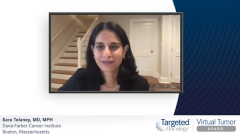
Case 2: Sequencing Treatments for HER2+ Breast Cancer
Episodes in this series

Ruta Rao, MD: Now that we’ve talked about, as you described it, our embarrassment of riches that we have to treat patients beyond first line in the HER2 [human epidermal growth factor receptor 2]– positive metastatic breast cancer setting, let’s touch on whether there are any key factors that drive treatment selection and sequencing, particularly when you think about exposure to certain treatments that the patient may have had in the HER2-positive early breast cancer setting. How does this influence your decision-making for the patients’ metastatic disease?
Komal Jhaveri, MD, FACP: That’s an important situation that we’re facing. Not only do we have multiple agents to think about in the metastatic setting that are currently approved, but we also need to understand the implication of the data that was preceding what we have right now. We don’t know if patients have already been exposed to pertuzumab in the early stage setting or with T-DM1 [trastuzumab emtansine] in the early stage setting with the KATHERINE trial. How do that data apply for them in the metastatic setting?
Let’s break this down. Let’s think about a scenario for which we’re thinking about purely metastatic disease, and we’re not thinking about these exposures. Right now, we’re doing THP [taxane, trastuzamab, pertuzumab] in the first-line setting, we’re doing T-DM1 [trastuzumab emtansine] in the second line setting, and in the third line setting, as we discussed, we’re thinking about multiple options, including trastuzumab deruxtecan and tucatinib, especially if they have active brain metastases. We’re dealing with that more with tucatinib-capecitabine-trastuzumab. We then have options such as neratinib and capecitabine based on the NALA trial, and we have trastuzumab with chemotherapy-based options.
As we were saying, even T-DM1 [trastuzumab emtansine] in the second line setting was based on the EMILIA study for which patients were not treated after being exposed to pertuzumab. We do that in clinic right now because we don’t have any other data there, and that might be evolving as we’re trying to study both tucatinib in the second-line setting with T-DM1 [trastuzumab emtansine], and we’re comparing head-to-head T-DM1 [trastuzumab emtansine] with trastuzumab deruxtecan in the second-line setting. That space can be evolving based on that data.
We are also utilizing pertuzumab in the first-line setting, 1 of the early-stage settings based on neoadjuvant approaches in adjuvant therapies and then based on KATHERINE, T-DM1 [trastuzumab emtansine] in the postresidual disease patients in the adjuvant setting. The way I’m thinking about the patients is that I’m still thinking about disease-free interval, which is what we did with T-DM1 [trastuzumab emtansine] as well. If we have patients in the early stage setting, who have progressed after 6 months of completion of adjuvant therapy, I’m still offering them THP [taxane, trastuzamab, pertuzumab]–based therapy as first-line treatment. If I have a patient who is progressing in less than 6 months and had not seen T-DM1 [trastuzumab emtansine] in the early stage setting, then think T-DM1 [trastuzumab emtansine] can be offered as an option in the first-line setting based on the EMILIA study and based on some data that we got for noninferiority from the MARIANNE trial. That could be 1 option.
We don’t have concrete data, but if I have a scenario where patients, based on the KATHERINE trial, got in the postresidual disease setting T-DM1 [trastuzumab emtansine] and then progressed within 6 months, we can still get away with giving them THP [taxane, trastuzamab, pertuzumab] at that point first. If we have a clinical trial option that we can offer, we could offer that as well. I doubt that that proportion of patients who have gotten taxane-HP [trastuzamab, pertuzumab]–based therapies, who had residual disease, and who then got T-DM1 [trastuzumab emtansine] is going to be high. We’re not seeing many such patients progressing quickly and becoming metastatic so soon. That is not a scenario that is common in the clinic, but if that were to exist theoretically, based on the disease-free interval, we can offer these, and the changing treatment landscape based on the ongoing trials will further change our management strategies.
Transcript edited for clarity.














































